Your AR-15 is a precision machine. Just like a car engine or equipment in a machine shop, it needs regular attention and maintenance – especially if you’re using it as a day-to-day tool. In addition to running a bore snake or brush through your rifle and other basic cleaning you should do after every time you shoot it, a full stripped-down cleaning of your rifle should be done on a regular basis. About every 1000 rounds or so, take it all apart as we’ll detail in this article and it will go a long way to keeping your rifle cycling for years and years.
It’s important to do some cleaning after every time you hit the range and fire your rifle. The AR-15 is a firearm that needs to be well lubricated and relatively free of carbon build up and debris to run reliably. Different rifle set-ups, different quality parts, different ammunition, and many other factors will contribute to how clean your rifle runs versus how prone it may be to fouling. Before you start working, it’s important to have a properly prepared space. A clear workbench or table should provide enough room, but you’ll want it to be protected from the oils and any potential scratches. Not to mention protecting your rifle as well. To do this, we recommend a product like TekMat cleaning mats, which have a rubberized bottom for a non-slip, stable worksurface, or the Real Avid Universal Master Cleaning Station which comes with numerous cleaning supplies and helps keep them organized. If you don’t have a basic cleaning kit already, you can’t go wrong with our options from Otis Technology, Birchwood Casey, and many others.
A good baseline practice to do any time you shoot is to examine the bolt carrier group and chamber for buildup of carbon or any dirt and dust that may have gotten in or around your ejection port and wipe that off with a clean rag and some basic cleaning oil. Break-Free CLP or something similar are great choices for every-day maintenance and cleaning as they clean and lubricate in one solution. Use a little of that same oil and a bore snake, or brush set and cleaning patches, to clean the inside of the barrel. Carbon fouling can build up along the rifling or at any point where some lubrication may have pooled up. Two or three passes through the barrel should be plenty, but make sure there’s no excess oil leftover when you’re done. Always remember to clean your barrel by following the same path as the bullet travels.
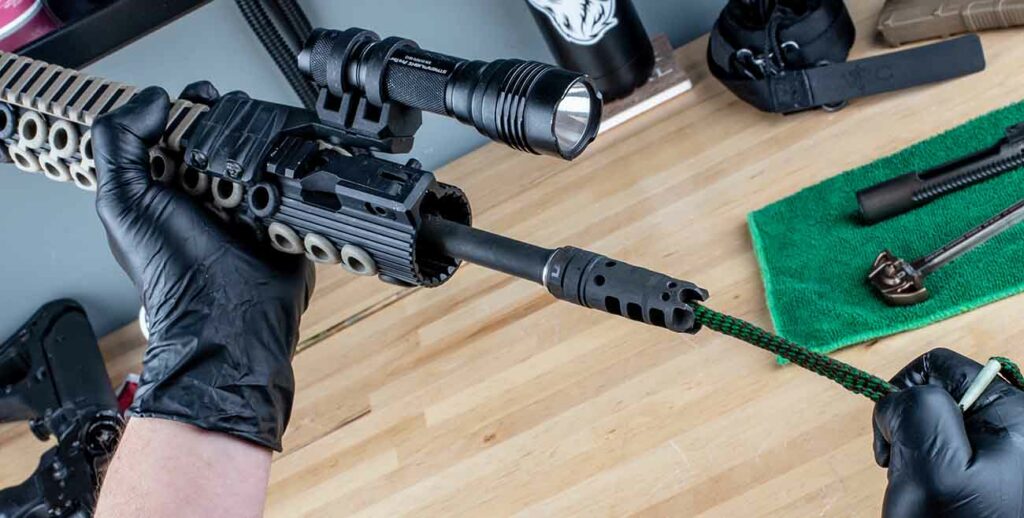
Every thousand rounds or so, a more detailed cleaning of your rifle will be in order – something a little more involved than just wiping it down. Don’t worry, it’s not too difficult. Additionally, routine inspection of your AR-15’s parts and components is a smart thing to get into the habit of doing – it may save you from a neglecting a small problem before it turns into a big one. Let’s get started.
Take out your BCG and disassemble it by removing the firing pin retaining pin, the firing pin itself, the bolt cam pin, and finally the bolt head. Clean the firing pin with a rag to remove any carbon buildup and make sure the pin tip is in good condition. It should be well rounded and smooth to ensure consistent primer strikes. Inspect the BCG body where the cam pin slides and make sure there’s no signs of wear or potential failure. Check your bolt head’s gas rings for any signs of wear, as well as the lugs for any cracks or chips. If there is excess carbon built up on the bolt head, a carbon scraper or knife can be used to carefully remove it.
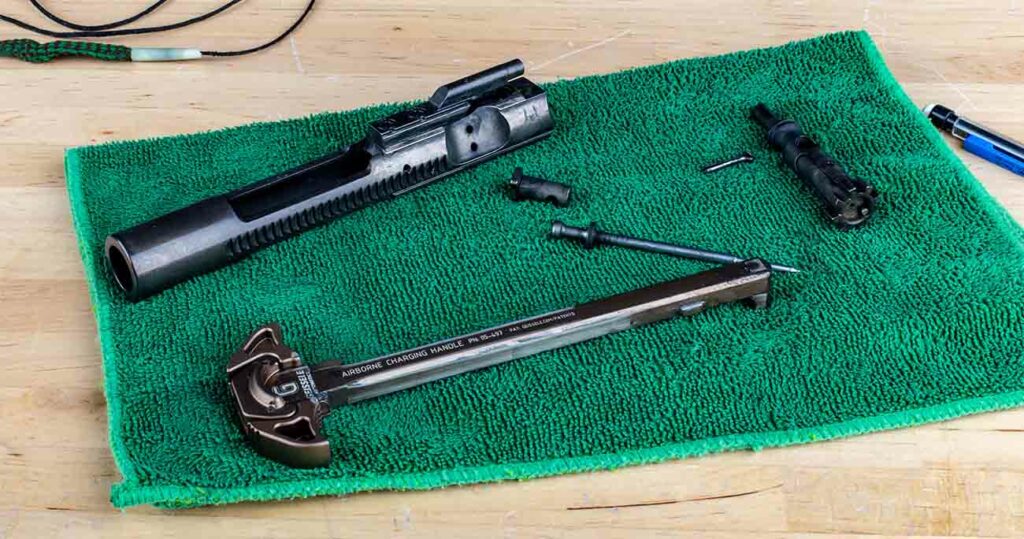
Clean through the center of the bolt head with a pipe cleaner, give it a good wipe down, and set it aside. Next, make sure your gas key’s screws aren’t loosening – these should be staked from the factory to prevent this issue, but it’s worth checking. Use a large-caliber barrel brush or just a cleaning patch with some cleaning solution to remove any carbon or dirt from the inside of the carrier. Finally, use a pipe cleaner to clean through the center, where the firing pin travels to the bolt head, and use a pipe cleaner or cotton swab to clean the gas key. If there’s additional excessive carbon on other parts of your BCG, use your blade or a bolt scraper to remove it. Reassemble your BCG, looking it over it one last time for anything you may have missed. If no problems are present, give it a wipe-down with an oiled cloth and set it aside.
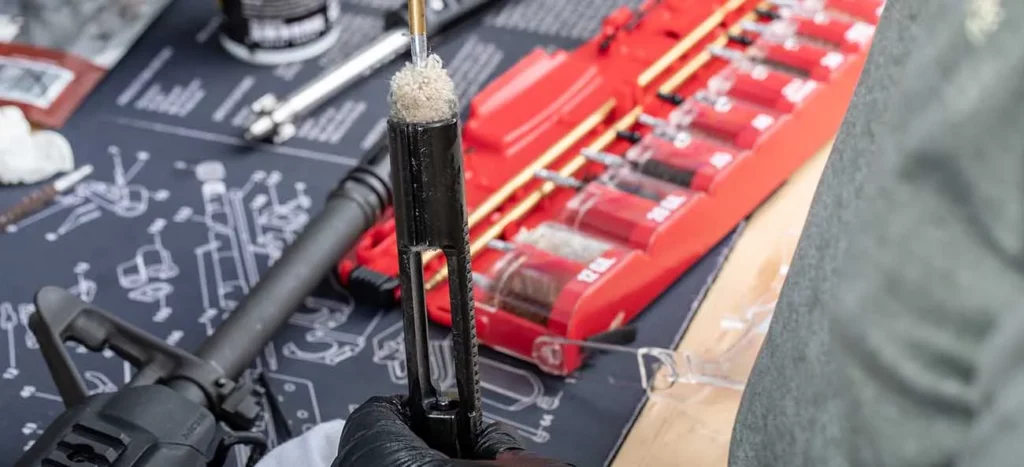
Inside your upper receiver and chamber area can get pretty dirty. There’s a ton of gas present, carbon particles, dirt, debris, and moving parts. Not a good combination. While you have your BCG removed, inspect the inside of your upper for excess carbon buildup and scrape it all away. Even if it’s not overly caked in fouling, it’s still worth your time to get as much of the gunk out as possible. Use some CLP or similar compound, and a cleaning cloth or old tooth brush and scrub it down. When you feel you’ve gotten as much grime off as you can, wipe out the inside with an oiled rag. You can remove your gas tube to clean the inside of the upper if you’re so inclined, but cleaning around it with a brush or cotton swab isn’t too difficult. Whether you leave it in place or remove it, you can use a gas tube pipe cleaner or some other gas-tube-specific cleaning tool and a few dabs of cleaner to clear the inside of the tube.
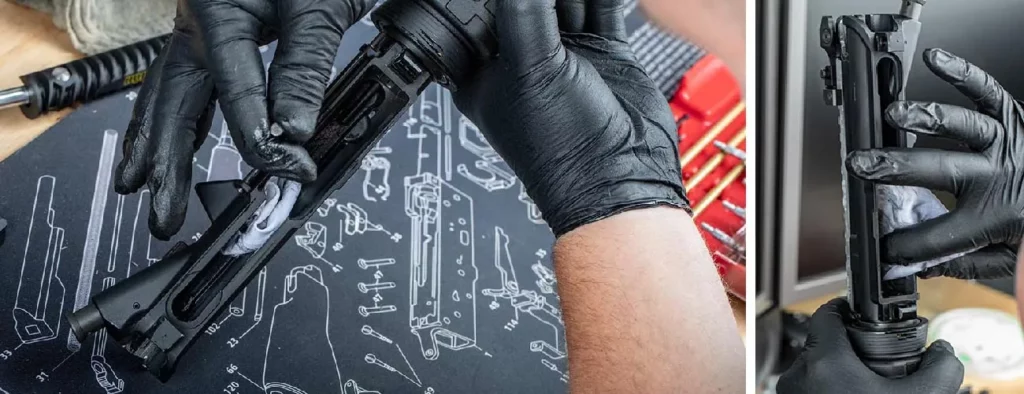
Some people never touch their gas tube, citing that the high gas pressure is enough to keep it operational. This is essentially true. But some of us just like to get every component as clean as possible every so often. Do it if you want, don’t do it if you don’t. If you do, be careful. Lose your pipe cleaner or a piece of your tool down the tube and it’s going to be a real pain to retrieve. Some would say it’s not even worth the risk.
The inside of the lower receiver doesn’t normally come in contact with too much dirt, grime or carbon fouling. If you shoot suppressed or use subsonic ammo often, you may need to clean the internals of your lower more regularly. In general, if anything is gumming up the works around your trigger group, safety selector, and takedown pins, it will be easy to remove with some compressed air or a cotton swab. It’s not unheard-of for a blown primer or some flakes of brass to fall into the lower receiver, so just give it a good once-over. All that said, some attention should be paid to your trigger and hammer on occasion. Keeping your hammer’s seer and disconnector surfaces clean and in good condition is important to your rifle’s reliability.
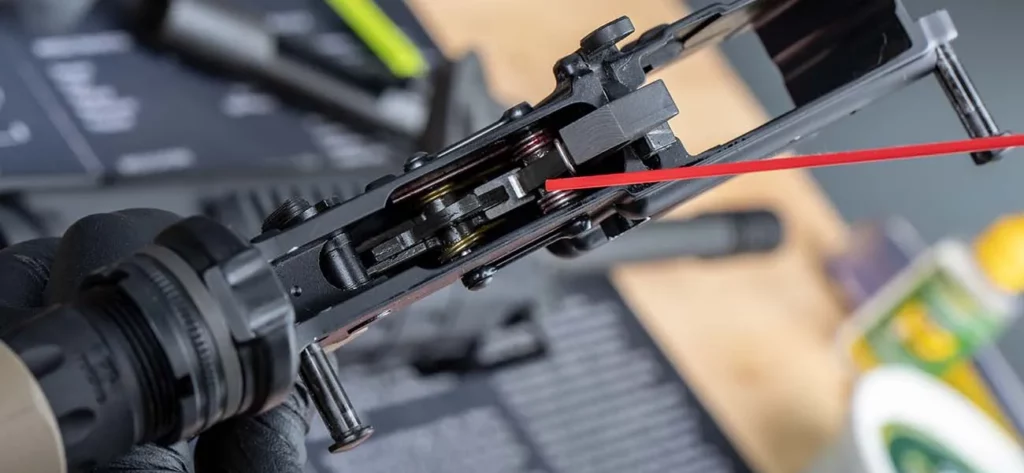
A small amount of trigger grease is also a good idea to keep things smooth — friction is the enemy. Speaking of which, if your safety selector or takedown pins aren’t moving smoothly, do a little inspection and see what the issue might be. Most of the time they’re just dirty or in need of some go-go juice. We’ll use the heavy-duty stuff later. For these parts, even some WD-40 will do. If you end up needing to take your selector switch or pivot and takedown pins out to clean more thoroughly, or to replace a detent or detent spring, just remember to be extremely careful as those small parts are very easy to lose or confuse. Don’t take them all out at the same time – pick one to remove completely, clean or replace, and reassemble it completely before moving on.

If you end up needing to take your selector switch or pivot and takedown pins out to clean more thoroughly, or to replace a detent or detent spring, just remember to be extremely careful as those small parts are very easy to lose or confuse. Don’t take them all out at the same time – pick one to remove completely, clean or replace, and reassemble it completely before moving on.
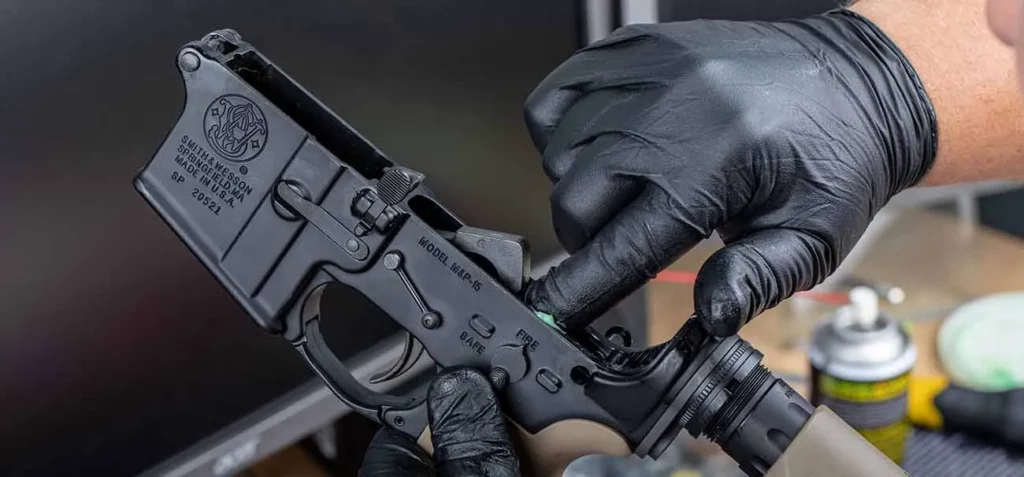
Your buffer system can be easy to neglect but it’s a part of your rifle that’s taking a lot of abuse, so you need to keep an eye on it. If the face of your buffer or the rear rubber pad is cracked or damaged in any way after thousands of rounds slamming back and forth, replace the buffer. It can happen, especially if you’re running your rifle hard, using a carbine length gas system or are hand-loading particularly powerful ammunition.
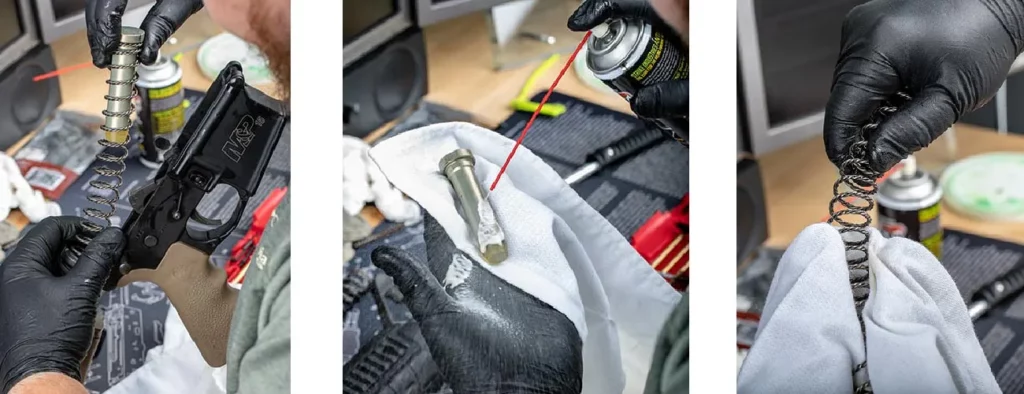
If your buffer spring is dirty or oily, wipe down the outside with a rag then use a screwdriver or cleaning rod to push the rag through the center. Use that same rod and a clean rag to take care of the buffer tube. Check the buffer retaining pin for signs of damage or wear and replace it if need be.
From here on out, the remaining components generally just need to be checked periodically to make sure all the hardware is still tight and not in danger of coming loose with a few rounds downrange.
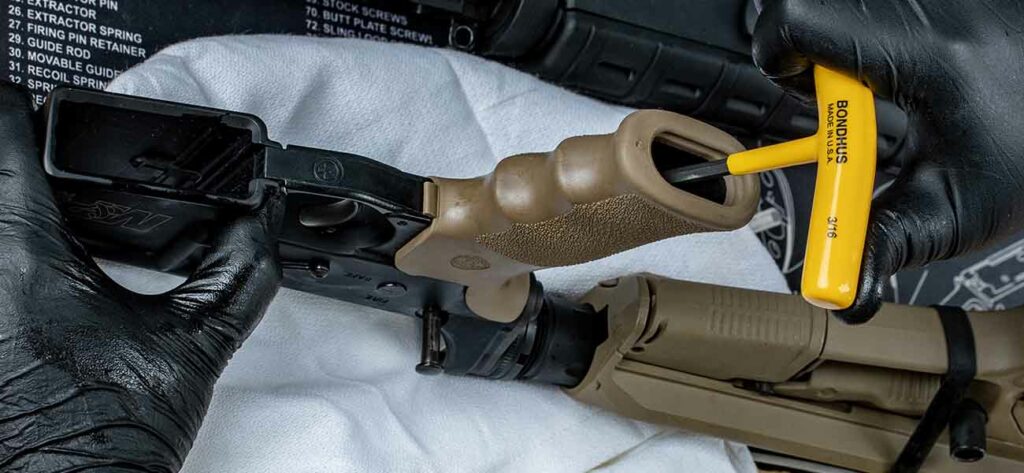
Things like your pistol gripscrew, scope mount, stock assembly and muzzle device should be checked as often as you shoot for any signs that something is out of whack. If you run a suppressor, it’s important to keep it clean around the threads, or around the QD mount if you use one, so that the extreme amounts of carbon buildup don’t seize your suppressor onto your barrel.
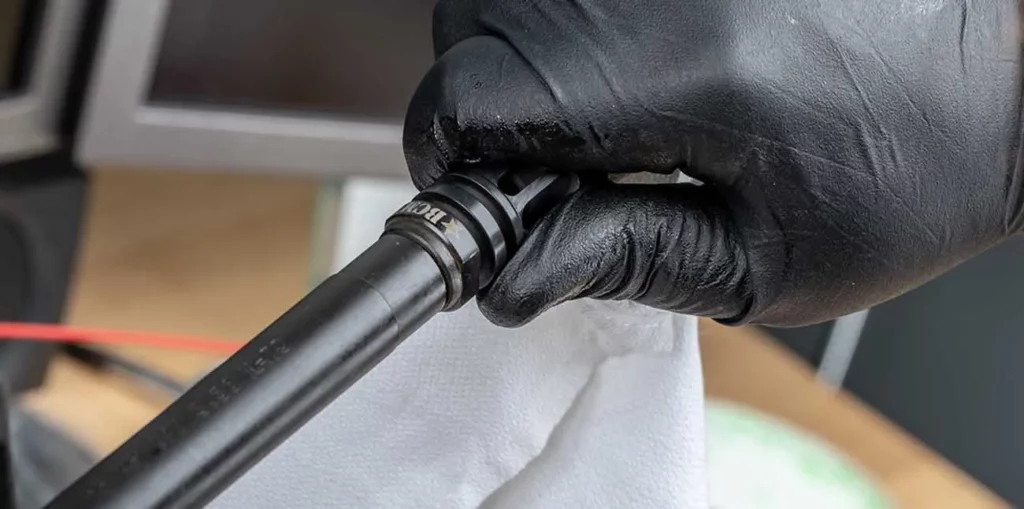
People don’t often inspect their magazines, but that is important too as their ability to reliably feed ammo into the chamber is obviously crucial. Get into the habit of dissembling magazines and cleaning them every year or so just for good measure, especially if you shoot a lot and live in dusty desert-type areas.
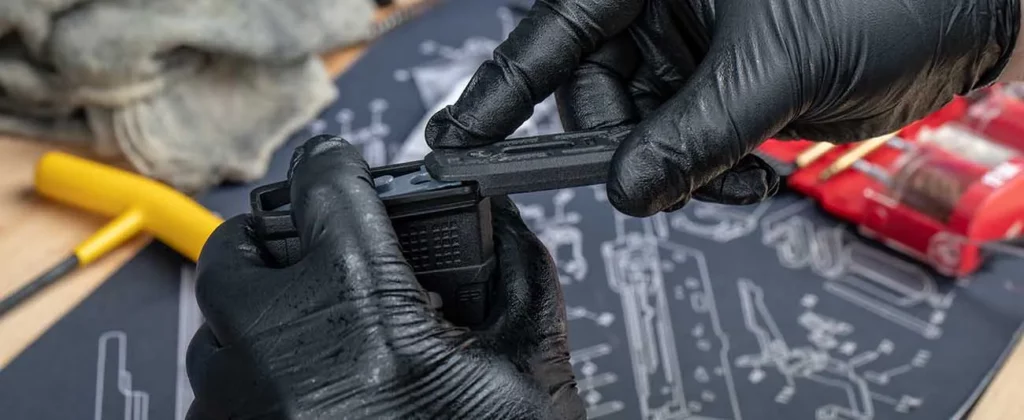
Every so often just be sure to check the integrity of the feed lips and function of the follower. Check the feed ramps in your barrel extension to ensure each round’s path to the chamber is a smooth ride. Over time it can be possible for the magazine spring to get dirty with dust, sand, or carbon build up.
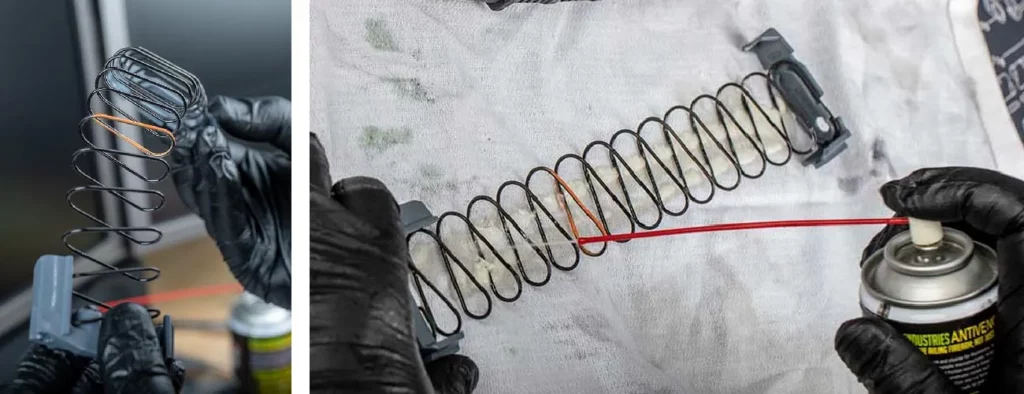
Alright. You’ve got your rifle disassembled, you’ve inspected and cleaned all the internals. Time to lube up, return everything to its place, and function test.
As you’ve cleaned, you should have been wiping down every metal component with an oiled rag as you went. All your components including your barrel should have a good layer of oil on them for protection. A little extra lube on some key areas is still a good idea. A drop of gun lube or grease, such as Slip 2000 EWG / EWL or ALG Go-Juice are going to be what you’re looking for here, a step above the basic CLP we’ve been using. Put a bead on each end of the BCG’s side rails, top and bottom, and along the center of the bottom.

Along the rearward facing surfaces of the locking lugs should also get a little dab to ensure they can unlock with ease. Put your rifle back together and check that all is operating smoothly. If you’ve got some dummy rounds, you can even check your magazines and extractor’s operational integrity.

Depending on how hard you use your rifles, how frequently, and where, your maintenance schedule is going to vary. But this outline of how to break down, completely clean, lubricate, and ultimately maintain your AR-15 will be beneficial to you regardless of how many times a year you refer to it. Keeping your AR-15 clean and taking care of the internal components will go a long way to protecting your investment and keeping your rifle shooting for years.
As always, if you ever have any questions about firearms parts, accessories, or anything else firearms related, give us a call at (713)-344-9600, or send us an email at info@primaryarms.com. Our in-house team, based here in Houston, Texas, is ready to help you out, whatever your need may be. That is always will be the Primary Arms mission – to serve you better than anyone else!



